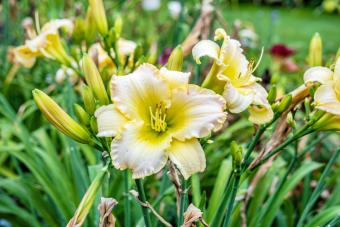
Impatiens are among the most popular bedding plants available today. That's because they're so easy to grow and bloom all summer long — even in the darkest corners. And they come in an amazingly wide range of colors. They are ideal for containers, hanging baskets, and beds.
| General Information |
| Scientific name - Impatiens Planting time - Spring Bloom time - Late spring through fall Uses - Flower beds, mass plantings, containers, hanging baskets |
| Scientific Classification |
| Kingdom - Plantae Division - Magnoliophyta Class - Magnoliopsida Order - Ericales Family - Balsaminaceae Genus - Impatiens |
| Description |
| Height - Varies by type Spread - Varies Habit - Busy or compact Texture - Medium Growth rate - Moderate Flower - Pink, purple, red, orange, yellow, white |
| Cultivation |
| Light Requirement -Partial to deep shade Soil - Organic, well-drained Drought Tolerance - Low Hardiness - Tender annual |
Growing Tips
Impatiens love warmth, so don't plant them too early. Wait until all danger of frost has passed and the ground has warmed up. They prefer rich soil in light to deep shade.
Summer care is easy. Keep plants moist, but avoid water-logged soil. Deadheading is seldom necessary. If your plants get scraggly after a couple of months, prune them back by one-third and they'll soon grow back bushier.
Starting Seeds
Impatiens can be difficult to start from seed, so it's easier to buy trays of plants in the spring. If you do start your own seeds, you'll need to sow them 8 to 10 weeks before the last frost date. Seeds need warmth-70 to 75 degrees Fahrenheit-and high humidity to sprout; try covering the tray with a sheet of clear plastic. When seedlings appear, in two to three weeks, remove the plastic and lower the night temperature to about 60 degrees. Wait until two weeks after the last spring frost to set plants outside.
Recommended Impatiens
There are so many gorgeous impatiens to choose from.
- I. walleriana, is most commonly grown. Bushy plants are covered in flat-faced flowers all summer. Dwarf forms, growing 8 to 10 inches tall on compact plants, include the Accent, Elfin, and Elfin Improved series. Tall forms such as the Blitz series grow 12 to 14 inches tall.
- I. balsamina, garden balsam, is an old -fashioned species. Cup-shaped blooms are borne close to the central stem and partially hidden by foliage. Victorian gardeners removed some leaves to better display the flowers. Plants grow 12 to 24 inches tall and come in shades of pink, red, purple, and white.
- I. hawkeri, New Guinea impatiens originated in New Guinea and were introduced in the United States in 1970. Many new, improved cultivars have been developed over the last 25 years and they have become popular patio and landscape plants.
- New Guineas have green, bronze, or variegated leaves and large, showy flowers up to 3 inches in diameter. Flower colors vary from white and pale pink to bright pink, red, violet, and orange.
- New Guineas prefer more sun than garden impatiens but still do best in morning sun and afternoon shade.
- They require moist, well-drained soil.
- Yellow impatiens are relative newcomers. A variety called 'Jungle Gold' has buttery yellow, bell-shaped blooms with red-streaked throats. Unlike standard impatiens, 'Jungle Gold' holds its flowers well above its glossy, deep green leaves. It prefers slightly less water and a little more shade than traditional impatiens. In pots, it pairs well with yellow croton and lime green coleus.
Uses
Impatiens look great almost any way you use them. They are terrific low-maintenance bedding plants for large or small landscapes.
- Impatiens are great for brightening a dark and dreary corner.
- In pots, combine them with colorful foliage plants such as coleus, caladium, and lamium.
- In pots, combine them with trailing plants such as ivy, lysimachia, or sweet potato vine.
- Impatiens make a beautiful ground cover in front of a shrub border.
- Interplant them in drifts among your perennials.
- Plant masses of single color for a particularly eye-catching display.
- If you can't decide which color to plant, plant them all. Mixed colors look great blanketing the ground beneath shade trees or in mixed-theme baskets and containers.
Other Annuals for Shade
- Begonia
- Browallia
- Caladium
- Coleus
- Lobelia
Other Easy Annuals to Grow
- Marigold
- Petunia
- Salvia
- Zinnia
- Geranium
Let Spring Bloom
When you want a colorful garden, impatiens are the perfect spring annuals to plant. They're pretty, bright, and easy to care for.







